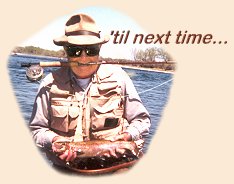
| ||
|
October 13th, 2003
|
|
Here is a letter from John Claassen, the author of the article on mayflies which emerge as duns which sparked a great deal of interest here:
October 2, 2003
Dear Bert,
I am flattered that I may have been momentarily
regarded as an authority on aquatic insects. Of
course, nothing could be further from the truth.
Although I have PhD credentials, the credentials
certainly do not apply to the field of entomology.
However, as a result of my scientific bent, I find
myself simply writing articles on aquatic insects
to increase my understanding of fly fishing and
hopefully in the process, I will impart some insight
to other fly fishing anglers.
Since I have only studied fly fishing for a limited
time (almost a decade now), when I do write, I am
careful to base my writings on sources that I regard
more qualified than I. In this case my research into
heptageniids led me to two sources which are cited at
the end my article. One article I suspect was written
by the resident entomologist at the McCloud Preserve
in California. His name was not disclosed in the McCloud
Preserve newsletter. The other reference was written by
Jim Schollmeyer, a well respected trout fishing authority,
author, and lecturer. Without attempting to discredit
Jim, I suspect that Jim's understanding of entomology
was largely based on knowledge imparted by his friend
Dr. Richard Hafele, a specialist in entomology. Jim's
stream experience has undoubtedly confirmed his
understanding of aquatic insects.
The article appearing in the McCloud Preserve Newsletter
specifically states that with regard to heptageniids
"that metamorphosis from nymph to subimago takes place
underwater rather than at the water-air interface like
so many other mayflies". The article implies that
flatheads are a distinct group within the clinger family
that can exhibit this behavior. The article further states
that the genera Rhithrogena and Epeorus
are the most notable flatheads appearing within the Preserve.
Cinygmula also appear there.
In Schollmeyer's discussion of the Epeorus
mayfly, he states that Yellow Quills "leave their nymphal
shucks while still under water, either at the bottom or
close to the surface". In his discussions of other western
Heptageniidae he simply stated that the nymphs crawl to
calmer water before emerging. There the nymphs quickly
swim to surface where the duns waste no time emerging.
There may be a tacit assumption here that they could
really emerge from just below the surface since they
take flight so rapidly.
These two references agree and confirm that at least
one flathead emerges (Epeorus) from the
water column as a dun. Your research suggests that
Heptagenia are also capable of emerging
in the same way. I further checked with Dr. Hafele to
determine whether the heptageniids as a family practiced
this type of emergence. He indicated that some species
among the genera in this family emerge beneath the surface.
In particular, certain species within the Epeorus
(Yellow Quills), Heptagenia (PEDs), Rhithrogena
(Western March Browns), and Cinygmula (Blue Wing
Red Quill) genera exhibit this behavior. He interestingly
indicated that this behavior is not unique to species within
the Heptageniidae family. Genera in other families also
exhibiting this emergence behavior included the Mahogany
Dun (Paraleptophebia), the Green Drake
(Drunella grandis), and the PMDs (Ephermerella
). He cites a technical article by Edmonds and Berner
to support this position.
I regard these findings important to fly fishers because
they imply an approach to fishing with heptageniid patterns.
First, routinely fishing with heptageniid nymphal patterns
will be largely futile.. These invertebrates are so effective
at clinging to the bottoms of rocks that they simply are
not available to trout in the water column except during
a hatch. Second, nymphal patterns will be suitable for
use just as a hatch begins because the nymphs release
themselves from the rocks. Third, wet hackle and weighted
dun patterns can be effective as the hatch progresses.
These patterns would simulate an emerging nymph and a dun,
respectively. This technique is advised for use on the
McCloud River in California during their March Brown and
Yellow Quill hatches. I would conjecture that trailing a
nymph might be doubly effective.
I hope that this additional information will be helpful
to your readers.
Respectively
~ C. E. (Bert) Cushing, aka Streamdoctor 105 W. Cherokee Dr. Estes Park, CO 80517 Phone: 970-577-1584 Email: streamdoctor@aol.com
|
| If you would like to comment on this or any other article please feel free to post your views on the FAOL Bulletin Board! |
 The 'Stream Doctor' is a retired professional stream ecologist and
author, now living in the West and spending way too much time
fly-fishing. You are invited to submit questions relating to
anything stream related directly to him for use in this Q & A Feature
at
The 'Stream Doctor' is a retired professional stream ecologist and
author, now living in the West and spending way too much time
fly-fishing. You are invited to submit questions relating to
anything stream related directly to him for use in this Q & A Feature
at